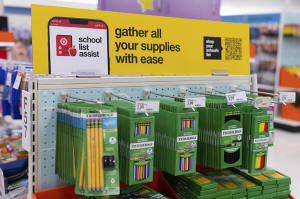Shopping for school supplies becomes a summer activity as families
juggle technology and tariffs
[August 14, 2025] By
ANNE D'INNOCENZIO
NEW YORK (AP) — Feeling nostalgic for the days when going back to school
meant picking out fresh notebooks, pencils and colored markers at a
local drugstore or stationary shop? The annual ritual is both easier and
more complicated for today’s students.
Big retail chains generate online lists of school supplies for customers
who type in their zip codes, then choose a school and a grade level. One
click and they are ready to check out. Some schools also offer busy
parents a one-stop shop by partnering with vendors that sell premade
kits with binders, index cards, pens and other needed items.
Yet for all the time-saving options, many families begin their
back-to-school shopping months before Labor Day, searching around for
the best deals and making purchases tied to summer sales. This year, the
possibility of price increases from new U.S. tariffs on imports
motivated more shoppers to get a jump start on replacing and refilling
school backpacks, according to retail analysts.
Retail and technology consulting company Coresight Research estimates
that back-to-school spending from June through August will reach $33.3
billion in the U.S., a 3.3% increase from the same three-month period a
year ago. The company predicted families would complete about 60% of
their shopping before August to avoid extra costs from tariffs.
“Consumers are of the mindset where they're being very strategic and
conscientious around price fluctuations, so for back to school, it
prompts them to shop even earlier,” said Vivek Pandya, lead analyst at
Adobe Digital Insights, the research division of software company Adobe
Inc.

Getting a head start
Miami resident Jacqueline Agudelo, 39, was one of the early birds who
started shopping for school supplies in June because she wanted to get
ahead of possible price increases from new U.S. tariffs on imported
products.
The teacher's supply list for her 5-year-old son, who started
kindergarten earlier this month, mandated specific classroom items in
big quantities. Agudelo said her shopping list included 15 boxes of
Crayola crayons, Lysol wipes and five boxes of Ticonderoga brand
pencils, all sharpened.
Agudelo said she spent $160 after finding plenty of bargains online and
in stores, including the crayons at half off, but found the experience
stressful.
“I am overwhelmed by the need to stay on top of where the deals are as
shopping has become more expensive over the years,” she said.
A lot of the backpacks, lined paper, glue sticks — and Ticonderoga
pencils — sold in the U.S. are made in China, whose products were
subjected to a 145% tariff in the spring. Under the latest agreement
between the countries, general merchandise from China is taxed at a 30%
rate when it enters the U.S.
Many companies accelerated shipments from China early in the year,
stockpiling inventory at pre-tariff prices. Some predicted consumers
would encounter higher prices just in time for back-to-school shopping.
Although government data showed consumer prices rose 2.7% last month
from a year earlier, strategic discounting by major retailers may have
muted any sticker shock for customers seeking school supplies.
Backpacks and lunchboxes, for example, had discounts as deep as 12.1%
during Amazon's Prime Day sales and competing online sales at Target and
Walmart in early July, Adobe Insights said. Throughout the summer, some
of the biggest chains have advertised selective price freezes to hold
onto customers.
Walmart is promoting a back-to-school deal that includes 14 supplies
plus a backpack for $16, the lowest price in six years, company
spokesperson Leigh Stidham said. Target said in June that it would
maintain its 2024 prices on 20 key back-to-school items that together
cost less than $20.
An analysis consumer data provider Numerator prepared for The Associated
Press showed the retail cost of 48 products a family with two school age
children might need — two lunchboxes, two scientific calculators, a pair
of boy’s shoes — averaged $272 in July, or $3 less than the same month
last year.

[to top of second column] |

Information on a school list assist and a QR code is displayed above
pencils for sale in the back-to-school supplies section of a Target
in Sherwood, Ore., Friday, Aug. 8, 2025. (AP Photo/Jenny Kane)
 Digital natives in the classroom
Numerator, which tracks U.S. retail prices through sales receipts,
online account activity and other information from 200,000 shoppers,
reported last year that households were buying fewer notebooks, book
covers, writing instruments and other familiar staples as students
did more of their work on computers.
The transition does not mean students no longer have to stock up on
plastic folders, highlighters and erasers, or that parents are
spending less to equip their children for class. Accounting and
consulting firm Deloitte estimates that traditional school supplies
will account for more than $7 billion of the $31 billion it expects
U.S. parents to put toward back-to-school shopping.
Shopping habits also are evolving. TeacherLists, an online platform
where individual schools and teachers can upload their recommended
supply lists and parents can search for them, was launched in 2012
to reduce the need for paper lists. It now has more than 2 million
lists from 70,000 schools.
Users have the option of clicking on an icon that populates an
online shopping cart at participating retail chains. Some retailers
also license the data for use on their websites and in their stores,
said Dyanne Griffin, the architect and vice president of
TeacherLists.
The typical number of items teacher request has remained fairly
steady at around 17 since the end of the coronavirus pandemic,
Griffin said. “The new items that had come on the list, you know, in
the last four or five years are more the tech side. Everybody needs
headphones or earbuds, that type of thing, maybe a mouse,” she said.
She's also noticed a lot of schools requiring clear backpacks and
pencil pouches so the gear can't be used to stow guns.
Enter artificial intelligence
For consumers who like to research their options before they buy,
technology and retail companies have introduced generative AI tools
to help them find and compare products. Rufus, the AI-powered
shopping assistant that Amazon launched last year, is now joined by
Sparky, an app-only feature that Walmart shoppers can use to get
age-specific product recommendations and other information in
response to their questions.

Just over a quarter of U.S. adults say they use AI for shopping,
which is considerably lower than the number who say they use AI for
tasks such as searching for information or brainstorming, according
to an Associated Press-NORC Center for Public Affairs Research poll
in July.
Some traditions remain
Before the pandemic turned a lot more people into online shoppers,
schools and local Parent Teacher Associations embraced the idea of
making back-to-school shopping easier by ordering ready-made bundles
of teacher-recommended supplies. An extra fee on the price helped
raise money for the school.
Market data from Edukit, a supplier of school supply kits owned by
TeachersList parent company School Family Media, shows that about
40% of parents end up buying the boxes, meaning the other 60% need
to shop on their own, Griffin said. She noted that parents typically
must commit no later than June to secure a bundle, which focus on
essentials like notebooks and crayons.
Agudelo said her son's school offered a box for $190 that focused on
basics like crayons and notebooks but didn't include a backpack. She
decided to pass and shop around for the best prices. She also liked
bringing her son along for the shopping trips.
“There’s that sense of getting him mentally prepared for the school
year,” Agudelo said. “The box takes away from that.”
All contents © copyright 2025 Associated Press. All rights reserved |